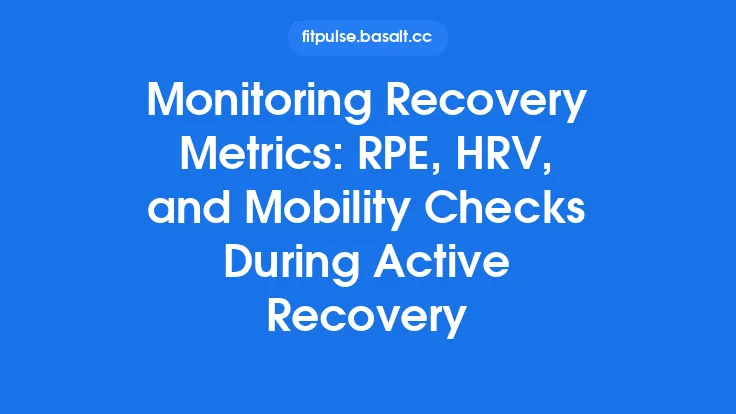When it comes to prescribing how hard a set should feel, the language we use can make a huge difference in how effectively athletes and everyday lifters translate a plan into real‑world performance. Intensity isn’t just a number on the barbell; it’s a blend of objective load, subjective perception, and the margin of effort left in the tank. Understanding the three most common tools—percentage‑based loading, Rate of Perceived Exertion (RPE), and Reps‑in‑Reserve (RIR)—gives coaches and trainees a flexible toolbox for matching effort to goals, fatigue, and day‑to‑day variability.
The Classic Approach: Percentage‑Based Loading
What It Is
Percentage‑based loading expresses the prescribed weight as a proportion of a known maximal capacity, most often the one‑rep max (1RM). A typical prescription might read “3 × 8 at 70 % 1RM.”
Why It Remains Popular
- Simplicity – A single number tells the lifter exactly what to load.
- Objectivity – The load is anchored to a measurable benchmark, which can be useful for tracking strength gains over time.
- Program Compatibility – Many classic periodization models (linear, undulating, block) are built around percentage schemes.
Limitations to Keep in Mind
- Day‑to‑Day Variability – Sleep, nutrition, stress, and even minor injuries can shift a lifter’s capacity, making a static percentage feel too easy or too hard on any given day.
- Testing Frequency – Accurate percentages require a reliable 1RM (or a close estimate). Frequent maximal testing can be impractical or counterproductive for some athletes.
- Transferability Across Exercises – A 70 % 1RM squat does not necessarily feel the same as 70 % 1RM bench press because of differing muscle‑group fatigue, technique demands, and leverage.
Practical Tips for Using Percentages Effectively
- Use Submaximal Estimates – Instead of a true 1RM, many coaches rely on a 5RM or 3RM test and apply conversion formulas (e.g., Epley, Brzycki) to estimate 1RM. This reduces risk while still providing a solid reference.
- Build in “RPE Buffers” – When prescribing a percentage, add a note such as “RPE ≤ 8” to give the lifter room to adjust the load based on how they feel that day.
- Re‑Test Periodically – Schedule 1RM or 5RM assessments every 4–8 weeks, depending on the training cycle, to keep the percentage chart current.
- Consider Exercise‑Specific Adjustments – For complex lifts (e.g., Olympic lifts, kettlebell swings), use a lower percentage of the 1RM or a separate “technical” max to account for skill demands.
Subjective Intensity: Rate of Perceived Exertion (RPE)
Defining RPE in Strength Training
RPE is a numeric scale that captures how hard a set feels relative to the lifter’s maximal effort. The most common version in resistance training is the 1–10 scale, where:
- RPE 10 = “I could not have performed another rep.”
- RPE 9 = “I could have performed one more rep.”
- RPE 8 = “I could have performed two more reps,” and so on.
How RPE Differs From Traditional “How Hard” Scales
Unlike the Borg scale used in cardio (which measures overall physiological strain), strength‑training RPE is anchored to the repetition ceiling of the set. This makes it directly translatable to load adjustments: a set at RPE 8 with 8 reps suggests the lifter could have done 10 reps with the same weight.
Benefits of RPE‑Based Programming
- Auto‑Regulation – The lifter can increase or decrease the load on the spot, matching the day’s readiness without needing a new test.
- Individualization – Two athletes using the same RPE may lift different absolute loads, reflecting personal strength, fatigue, and technique.
- Enhanced Learning – Regularly rating effort trains athletes to become more attuned to their bodies, improving long‑term self‑regulation.
Implementing RPE in a Training Plan
- Start With a Baseline – Have the athlete perform a set at a known percentage (e.g., 75 % 1RM) and record the RPE they experience. This creates a personal mapping between % and perceived effort.
- Prescribe Both Load and RPE – Example: “4 × 6 at 70 % 1RM, RPE ≤ 8.” The athlete loads the bar to 70 % 1RM but can drop the weight if the set feels harder than an 8.
- Use “RPE Targets” for Progression – When the athlete consistently hits a lower RPE than prescribed (e.g., RPE 6 when the goal is 8), increase the load by 2.5–5 % for the next session.
- Document RPE Trends – Tracking RPE across weeks reveals patterns of fatigue, recovery, and adaptation, informing macro‑cycle adjustments.
Common Pitfalls and How to Avoid Them
- Inconsistent Rating – New lifters may over‑ or under‑estimate effort. Provide clear examples and conduct “rating drills” where they perform a set, then compare their RPE to the actual reps‑in‑reserve (see next section).
- Using RPE for All Sets – Early in a program, it’s often best to apply RPE to the last set of a movement, where fatigue is most evident, while keeping earlier sets at a fixed percentage.
- Neglecting Technique – A set may feel “easy” (low RPE) but still have poor form. Emphasize that RPE reflects effort, not technical quality.
The Bridge Between Objective and Subjective: Reps‑in‑Reserve (RIR)
What RIR Measures
RIR quantifies the number of additional repetitions an athlete believes they could have completed with proper form before reaching failure. For example, a set of 8 reps performed with an RIR = 2 means the lifter thinks they could have done two more reps (i.e., 10 reps) before failure.
Relationship to RPE
RPE and RIR are two sides of the same coin:
- RPE = 10 – RIR (approximately).
- RPE 9 ↔ RIR 1
- RPE 8 ↔ RIR 2, etc.
Because RIR is expressed directly in reps, many coaches find it more intuitive when programming rep ranges.
Why RIR Is Useful
- Fine‑Grained Load Adjustment – A lifter can add 2.5 % more weight if they finish a set with an RIR > 3, or drop weight if RIR < 1.
- Safety – By stopping a set before true muscular failure, RIR helps preserve joint health and reduces excessive central nervous system fatigue.
- Compatibility With Hypertrophy Research – Studies often prescribe “3 × 10 at 2 RIR,” making RIR a research‑backed metric.
Integrating RIR Into Sessions
- Set an RIR Goal for the Last Set – Example: “3 × 8, last set RIR = 2.” The athlete may use a slightly heavier load for the first two sets, then adjust on the final set to hit the RIR target.
- Use RIR for “Back‑Off” Sets – After a heavy top set, prescribe a lighter set at a specific RIR (e.g., “Back‑off set: 1 × 12 at RIR = 3”). This provides volume without excessive fatigue.
- Combine With Percentage Loading – Start with a percentage (e.g., 75 % 1RM) and let the athlete fine‑tune the exact load to achieve the desired RIR.
Teaching Athletes to Estimate RIR Accurately
- Demo Sessions – Have the lifter perform a set to true failure, then count how many reps they could have added. Use this as a reference point.
- Video Review – Record a set, pause a few reps before failure, and ask the athlete how many more they think they could have done. Compare with the actual number.
- Progressive Feedback – During the first few weeks, ask the lifter to report both RPE and RIR. Discuss any discrepancies to calibrate perception.
Choosing the Right Intensity Tool for Your Context
| Situation | Best Primary Metric | Why |
|---|---|---|
| Highly Structured Powerlifting Cycle | Percentage‑based loading (with periodic 1RM testing) | Provides clear, objective targets for maximal strength phases. |
| Daily Auto‑Regulation for Recreational Lifters | RPE (or RIR) | Allows day‑to‑day load adjustments based on fatigue, sleep, stress. |
| Hybrid Programs (Strength + Hypertrophy) | RIR for volume work + percentages for heavy singles | RIR gives fine control over proximity to failure; percentages keep heavy lifts consistent. |
| Coaching Athletes New to Strength Training | RPE with simple 1–10 scale + occasional percentage checks | Builds perception skills while still offering concrete load guidance. |
| Research‑Oriented or Data‑Driven Programs | RIR (aligned with published protocols) | Directly matches the language used in scientific literature. |
In practice, most effective programs blend these tools. A typical week might look like:
- Day 1 (Heavy) – 3 × 5 at 85 % 1RM, RPE ≤ 8.
- Day 2 (Volume) – 4 × 10 at 70 % 1RM, last set RIR = 2.
- Day 3 (Recovery/Technique) – 2 × 8 at a load that feels RPE 6, focusing on form.
Programming Tips for Seamless Integration
- Create a “Load‑Adjustment Rule” – For example, “If the set finishes at RPE ≤ 7, add 2.5 % to the next session; if RPE ≥ 9, subtract 2.5 %.” This turns subjective feedback into a systematic progression.
- Use a Simple Log Template
Exercise | Set | Load | Reps | RPE | RIR | Notes
-------------------------------------------------
Squat | 1 | 140kg| 5 | 8 | 2 | Felt fresh
Recording both RPE and RIR (even if they are redundant) helps the lifter cross‑validate their perception.
- Periodize the Use of Metrics – Early macrocycles may rely heavily on percentages to establish a baseline. Mid‑cycle, introduce RPE/RIR for auto‑regulation. Late‑cycle, revert to percentages for peaking.
- Educate on “Technical Failure vs. Muscular Failure” – Emphasize that RPE/RIR should be based on the point where form would break down, not just the point where the muscle can’t produce another rep.
- Mind the Exercise Selection – For highly technical lifts (e.g., clean & jerk), keep the load at a conservative percentage and use RPE only as a secondary check. For more straightforward movements (bench press, leg press), RPE/RIR can be the primary driver.
Frequently Asked Questions
Q: Can I use RPE without ever testing my 1RM?
A: Yes. You can start with a rough estimate (e.g., 5RM) and use RPE to fine‑tune loads. Over time, the athlete’s internal scale becomes reliable enough that formal testing isn’t required each cycle.
Q: How does RIR differ from “leaving a rep in the tank”?
A: “Leaving a rep in the tank” is a colloquial way of describing RIR ≥ 1. RIR quantifies exactly how many reps are left, providing a more precise target.
Q: What if my RPE and RIR don’t line up (e.g., I rate a set as RPE 8 but think I have 4 RIR)?
A: This signals a calibration issue. Review recent sets, compare with actual performance, and adjust the internal mapping. Consistency improves with practice.
Q: Should I always aim for the same RPE across all sets of a movement?
A: Not necessarily. Early sets are often performed at a lower RPE to preserve quality, while later sets may target a higher RPE to ensure sufficient stimulus. The key is to define the intended RPE for each set in the program.
Bottom Line
Intensity prescription is a spectrum ranging from the concrete (percentage of a known max) to the nuanced (RPE and RIR). Each method offers distinct advantages:
- Percentage‑based loading gives clear, objective targets and is ideal for phases where maximal strength is the primary goal.
- RPE provides a flexible, day‑to‑day gauge of effort, enabling auto‑regulation without constant testing.
- RIR translates that subjective effort into a concrete rep count, bridging the gap between perception and measurable load adjustments.
By understanding the strengths and limitations of each tool—and by learning how to blend them—you can design programs that stay responsive to the athlete’s condition, align with scientific evidence, and ultimately drive consistent, sustainable progress.





